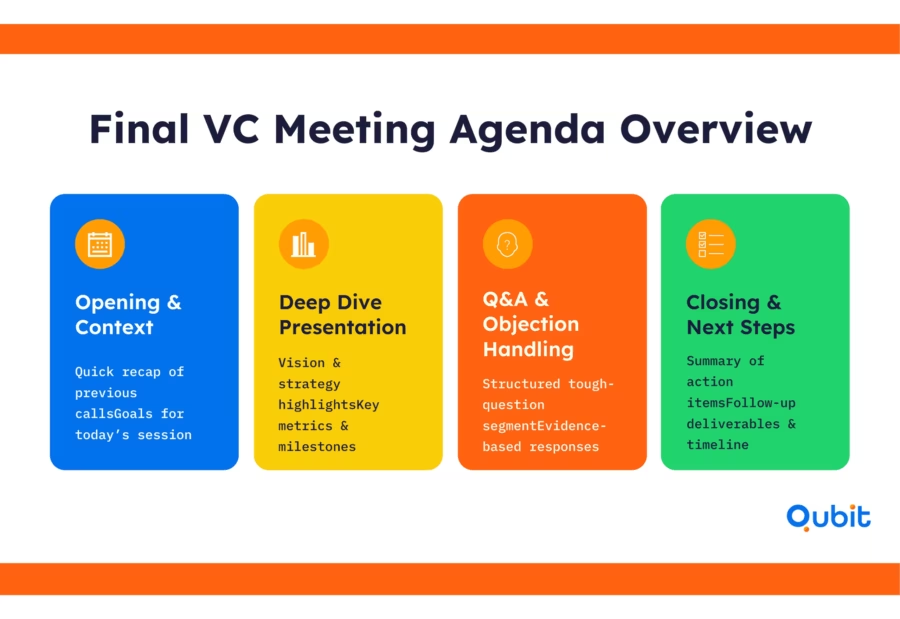Securing a venture capital deal often hinges on the final meeting, where your startup’s vision and readiness are put to the ultimate test. This critical moment demands thorough preparation, as it can determine whether your pitch resonates or falls flat. From refining your presentation to anticipating investor questions, every detail matters. Exploring investor outreach strategies furnishes a broader context that links early engagement methods with the nuances of final meeting preparation.
This blog is designed to equip you with actionable strategies for your final VC meeting preparation. Whether it’s perfecting your startup pitch readiness or addressing investor concerns, we’ll cover everything you need to know. Let’s jump right in!
What to Expect in Your Final VC Meeting
The final VC meeting marks a decisive moment in your fundraising journey, where investor impressions are solidified and critical decisions are made. This meeting is not just about presenting numbers; it’s about demonstrating your startup’s scalability, addressing risks, and showcasing your ability to execute effectively.

Investors will evaluate both qualitative and quantitative aspects of your pitch. They’ll focus on your ability to scale operations, mitigate risks, and deliver on projections. Precision in your data-driven narrative can significantly boost investor confidence, as highlighted by the growing emphasis on comprehensive due diligence in late-stage negotiations.
A striking statistic underscores the importance of these final discussions: 43.2% of Q4 2024's $74.6B VC deal value came from just five mega-deals. This concentration of funding highlights how pivotal late-stage negotiations are in determining overall outcomes.
Preparation for this meeting is key—ensure your pitch aligns with investor expectations and addresses their concerns comprehensively.
How to Prepare Effectively for VC Meetings
Preparation is the cornerstone of successful VC meetings. Start by revisiting previous interactions with potential investors to ensure continuity and alignment. Regularly updating your financial models is equally critical; accurate and up-to-date figures demonstrate your startup’s readiness and reliability.
Conducting mock interviews is another powerful strategy. These simulations help refine your pitch and address potential questions with confidence. Additionally, researching targeted VC firms allows you to tailor your presentation to their investment focus, increasing your chances of a positive outcome.
Expert insights, such as those from Ramana Nanda, emphasize that early preparation significantly improves deal flow. Tools like Fondo Accounting can streamline your financial preparations by automating bookkeeping and reducing last-minute errors. Explore Fondo’s all-in-one accounting platform to simplify your startup’s financial management before critical VC meetings.
How to Craft a Story That Makes Your Pitch Stand Out
A pitch that resonates often begins with a story that connects on both emotional and analytical levels. By weaving your personal journey into the narrative, you create a foundation of authenticity that investors can relate to. However, the real impact comes when this story is seamlessly tied to a compelling market opportunity.
A well-crafted narrative balances emotional appeal with hard data. Share the challenges you’ve overcome and the insights gained, but ensure these moments lead to a clear demonstration of your startup’s readiness to address market needs. For instance, pairing your personal story with statistics that highlight market demand or growth potential builds credibility and investor confidence.
Smooth transitions between your personal journey and market opportunity are essential. Practice delivering your pitch until the narrative flows naturally, ensuring each section complements the next. Additionally, insights into multi-channel investor outreach strategies expand your perspective on utilizing various platforms, which resonates with the steps you take before a final VC meeting.
Ultimately, a pitch that stands out is one that balances human connection with data-driven insights. This combination not only captures attention but also leaves a lasting impression on your audience.
How to Handle Tough Questions from Investors
Facing tough questions from investors is an opportunity to showcase your expertise and leadership. Addressing these challenges effectively requires preparation, transparency, and a structured approach to communication.
1. Prepare Evidence-Based Responses
Investors often probe strategic, financial, and operational aspects of your business. Anticipate these questions by preparing data-driven answers that highlight your company’s strengths and address potential concerns. Reference guidance on capital raising pitfalls, such as those outlined in Fix Capital, to tackle objections with clarity and confidence.
2. Emphasize Honesty and Follow-Up
Transparency builds trust. If you don’t have an immediate answer, acknowledge it honestly and commit to providing a detailed follow-up. Promptly delivering the promised information demonstrates reliability and strengthens investor relationships.
3. Rehearse Structured Q&A Sessions
Practice makes perfect. Conduct mock Q&A sessions with your team to refine your responses and ensure consistency. Align your preparation timeline with market rhythms by considering the best time to reach out to investors, reducing last-minute surprises during meetings.
Handling tough questions effectively not only reassures investors but also positions you as a confident leader capable of steering your business toward success.
Deliver Your Presentation with Confidence and Impact
The way you deliver your pitch can make or break its success. Consistent practice is the cornerstone of confident and natural delivery, ensuring that your message resonates with investors. Begin with a strong opening that captures attention and sets the tone, and conclude with a memorable closing that leaves a lasting impression. These moments are critical for showcasing your expertise and vision.
Visual aids play a vital role in enhancing your verbal narrative. Use clear and visually consistent data visuals to simplify complex information and improve audience comprehension. Subtle design elements, such as polished social sharing buttons, can also maintain the professional tone of your presentation. For inspiration, check out Webflow’s blog post on customizing social sharing buttons.
As you refine your pitch, consider tools like the best CRM for investor management to streamline tracking practice sessions and investor interactions.
Handle Meeting Logistics and Nail Your Follow-Up
A well-organized meeting sets the tone for professionalism and reliability. Begin by confirming the meeting format—whether virtual or in-person—and ensure all participants are aligned on the schedule and agenda. Testing equipment ahead of time is equally crucial, especially for virtual meetings, where technical glitches can disrupt the flow and leave a poor impression.
Post-meeting follow-ups are just as important as the meeting itself. Craft timely and thoughtful follow-up emails to reinforce key points discussed and maintain investor interest.
Proper logistical planning not only showcases your organizational skills but also ensures a seamless experience for investors. Combine this with effective meeting follow-up strategies to leave a lasting impression and build stronger connections.
Set Yourself Up for Long-Term Success After the VC Meeting
A polished pitch is more than just a presentation—it’s a reflection of your startup’s overall readiness and maturity. Investors often view thorough preparation as a direct indicator of broader business capabilities. When founders demonstrate a clear vision and meticulous planning, it builds confidence in their ability to deliver sustained success.
Take Front's Series A Success as an example. Their detailed preparation resulted in $10M raised from Social Capital, showcasing how strategic groundwork can secure significant funding. This level of diligence not only impresses venture capitalists during the meeting but also sets the foundation for long-term startup funding success.
How to Turn Your Funding Journey into a Success Story
Strategic preparation transforms the funding process into an opportunity for growth. By embracing dynamic financial modeling, founders can present data-driven insights that enhance pitch credibility. This approach ensures readiness for last-minute opportunities, allowing entrepreneurs to adapt and shine during critical moments. Investment pitch transformation begins with meticulous planning and a focus on impactful storytelling.
Showcase Your Product or Service
Capturing the essence of your product or service is vital when pitching to venture capitalists. Clear communication ensures investors grasp your offering's value and potential impact. Highlighting unique features and addressing market needs effectively can set the stage for a compelling pitch.
Share Your Vision and Strategy
A compelling pitch begins with a clear articulation of your vision and strategy. By sharing your long-term goals and the roadmap to achieve them, you demonstrate focus and foresight. Investors value clarity and alignment, so ensure your strategy reflects both ambition and practicality. This approach builds confidence in your ability to execute effectively.
Highlight Your Market Opportunity
Understanding your market potential is essential for success. Clearly defining and communicating this opportunity not only attracts investors but also aligns your team around shared goals. A well-articulated market opportunity demonstrates the demand for your solution and positions your business for sustainable growth.
Introduce Your Team and Leadership Strengths
Highlighting the expertise and cohesion of your team is essential for building trust and credibility. Showcase the leadership qualities that drive your organization forward, emphasizing collaboration, innovation, and strategic decision-making. A strong team dynamic not only reflects your company’s values but also demonstrates your ability to achieve impactful results in competitive markets.
Address Legal and Regulatory Considerations
Understanding legal and regulatory requirements is essential for a successful VC meeting. Investors often evaluate compliance as part of their decision-making process. Be prepared to address relevant laws, industry standards, and any jurisdiction-specific regulations that impact your business. This demonstrates professionalism and reduces potential risks, fostering confidence in your venture's operational integrity.
Explain Your Marketing and Branding Strategy
A well-crafted marketing and branding strategy amplifies your pitch by showcasing your unique value proposition and building trust with your audience. By aligning your brand identity with targeted campaigns, you create a cohesive narrative that resonates with potential clients and investors. Strong strategies not only attract attention but also foster lasting connections.
Demonstrate Your Operational and Infrastructure Capabilities
Showcasing operational efficiency and robust infrastructure is vital during a VC meeting. Investors seek assurance that your business can scale seamlessly while maintaining reliability. Highlighting streamlined processes and resilient systems not only builds confidence but also positions your venture as a dependable investment opportunity.
Conclusion
Securing success in VC meetings requires a combination of thoughtful preparation, a compelling narrative, and strategic Q&A handling. By focusing on crafting a clear, story-driven pitch deck and ensuring robust follow-up, founders can significantly enhance their chances of making a lasting impression. These strategies not only help communicate your vision effectively but also demonstrate your readiness to execute it.
We encourage founders to integrate these tactics into their approach, refining their presentations and interactions to align with investor expectations. If you're ready to elevate your pitch, we at Qubit Capital offer expert Pitch Deck Creation services to help craft a winning presentation.
Key Takeaways
- Thorough VC meeting preparation lays the groundwork for successful funding outcomes.
- A narrative that blends emotional storytelling with solid data captures investor interest.
- Skillfully handling tough questions sets your pitch apart from the competition.
- Careful logistical planning and timely follow-up reinforce investor confidence.
- Real-world examples, such as Front’s Series A success, demonstrate the effectiveness of these strategies.
Frequently asked Questions
How to prepare for a VC meeting?
Preparation begins with thorough research on the venture capital firm. Tailor your pitch deck to highlight your business’s strengths and practice answering potential questions. Additionally, compile a detailed due diligence checklist to address investor concerns effectively.


 Back
Back



